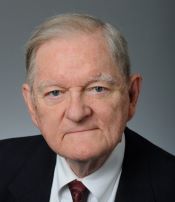
George Mason University might be a relative newcomer among the nation’s top-tier research hubs, but it is already well represented among the upper echelons of science.
Noted conservation biologist Thomas Lovejoy’s recent induction into the National Academy of Sciences was a remarkable achievement for George Mason University, and he is not alone among members of the Mason community who have been recognized for their extraordinary work in science.
Naomi “Lynn” Gerber, Harry van Trees, Vernon L. Smith and the late Andrew Sage also have been officially recognized by the various national academies, putting Mason among elite company.

“Each additional academy member is another indication of Mason’s leadership as a very young institution,” said Lovejoy, a University Professor of Environmental Science and Policy within the College of Science and the scientific director of Mason’s Institute for a Sustainable Earth.
Lovejoy, who is considered “the godfather of biodiversity” for coining the term, was inducted into the National Academy of Sciences in late April.
The National Academy of Engineering and the National Academy of Medicine (formerly the Institute of Medicine) work together as the National Academies of Sciences, Engineering and Medicine. The National Academy of Sciences is one of the oldest and most prestigious organizations to recognize academic leaders. The private, nonprofit institution was established by a congressional charter signed by President Abraham Lincoln in 1863.

Election to membership is considered one of the highest honors any scientist can receive.
Lovejoy joined Naomi “Lynn” Gerber, MD, a University Professor in the College of Health and Human Services, who was inducted into the National Academy of Sciences Institute of Medicine (now the National Academy of Medicine) in 2008; Vernon Smith, professor emeritus of economics and law at Mason, who was inducted into the Academy in 1995; and National Academy of Engineering members Harry Van Trees, distinguished research professor at Mason’s C4I and Cyber Center in the Volgenau School of Engineering, who was inducted in 2015; and late Andrew Sage, the founding dean emeritus of the Volgenau School of Engineering who was inducted in 2004.

Gerber said that being elected to the National Academy was something she never envisioned. Gerber, who is retiring from teaching this year after starting her medical career 1971, will remain the director of research of the Inova Health Care System’s Medicine Service Line.
“I am in a specialty—physical medicine and rehabilitation—which is not readily recognized by the public,” she said. “It really relates more to function and disability, and people with functional loss and disability are often not visible and not heard. So being a member of the National Academy and having the academy recognize physical medicine and rehabilitation is an enormous platform from which we can air important issues.”
Smith, whose career accolades include a 2002 Nobel Prize for Economic Sciences, said being recognized by the National Academy is like nothing else because it represents sciences across the board.

“So it’s a pretty special distinction,” said Smith.
Kenneth Ball, dean of Mason’s new College of Engineering and Computing, lauded both Van Trees and Sage for their lasting contributions to the university’s engineering program. Van Trees was the founding director at the C4I and Cyber Center, while Sage’s vision for a new school of engineering based on information technology was ahead of its time in the 1980s.
Current NAS membership totals approximately 2,400 members and 500 international members, 190 of whom have received Nobel Prizes.
